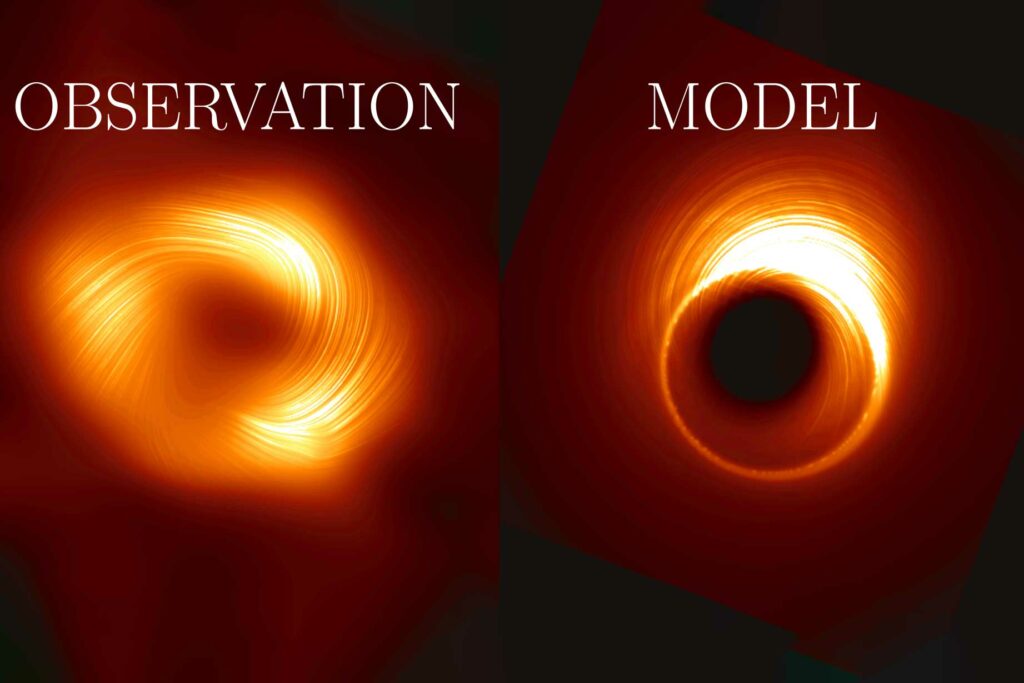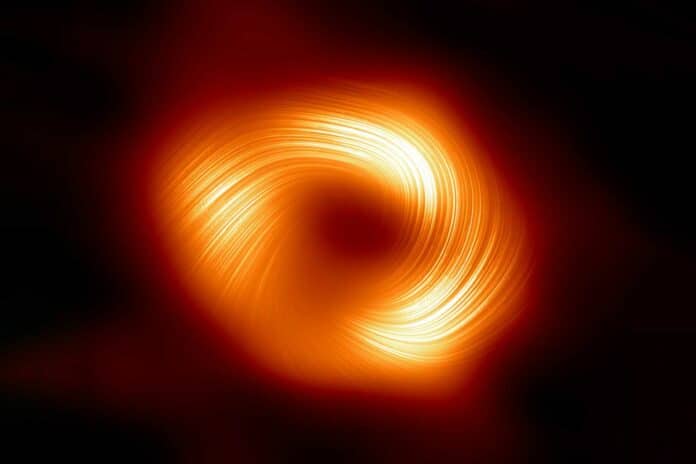Scientists released the first image of Sgr A* in 2022. The supermassive black hole in the Milky Way, located about 27,000 light-years from Earth, is smaller and less massive than the first black hole to be photographed, M87, by more than a thousand times. Still, the observations showed striking similarities. Scientists began questioning whether the two had any characteristics except appearance.
The group examined Sgr A* under polarized light to find out. The magnetic forces surrounding the M87 black hole (M87*) allowed the black hole to shoot strong jets of material back into the surrounding environment, according to earlier observations of light around the black hole. Expanding upon this research, the recently acquired images suggest that Sgr A* also fits this description.
Sagittarius A* (Sgr A*), a supermassive black hole, has well-organized and magnetic solid fields spiraling from its edge, as revealed by a new image from the Event Horizon Telescope (EHT) collaboration. This new image of the monster lurking at the center of the Milky Way galaxy, which was seen in polarized light for the first time, has shown a magnetic field structure that is remarkably similar to that of the black hole at the center of the M87 galaxy, raising the possibility that all black holes share strong magnetic fields. This resemblance also suggests that Sgr A* has a hidden jet.

Sara Issaoun, NASA Hubble Fellowship Program Einstein Fellow at the Center for Astrophysics | Harvard & Smithsonian, US, and co-lead of the project, said, “What we’re seeing now is that there are strong, twisted, and organized magnetic fields near the black hole at the center of the Milky Way galaxy. With Sgr A* having a strikingly similar polarisation structure to that seen in the much larger and more powerful M87* black hole, we’ve learned that strong and ordered magnetic fields are critical to how black holes interact with the gas and matter around them.”
Particles rotating around magnetic field lines induce a polarization pattern perpendicular to the field in the plasma surrounding these black holes. Astronomers can map the magnetic field lines of black hole regions and see events there in ever more vivid detail.
Harvard Black Hole Initiative Fellow and project co-lead Angelo Ricarte said, “By imaging polarised light from hot glowing gas near black holes, we are directly inferring the structure and strength of the magnetic fields that thread the flow of gas and matter that the black hole feeds on and ejects. Polarised light teaches us a lot more about the astrophysics, the properties of the gas, and mechanisms that take place as a black hole feeds.”
EHT Project Scientist Geoffrey Bower from the Institute of Astronomy and Astrophysics, Academia Sinica, Taipei, said, “Because Sgr A* moves around while we try to take its picture, it was difficult to construct even the unpolarised image. The first image was an average of multiple images owing to Sgr A*’s movement. “We were relieved that polarised imaging was even possible. Some models were too scrambled and turbulent to construct a polarised image, but Nature was not so cruel.”
Mariafelicia De Laurentis, EHT Deputy Project Scientist and professor at the University of Naples Federico II, Italy, said, “With a sample of two black holes — with very different masses and very different host galaxies — it’s important to determine what they agree and disagree on. Since both are pointing us toward strong magnetic fields, this may be a universal and perhaps fundamental feature of these systems. One of the similarities between these two black holes might be a jet, but while we’ve imaged a very obvious one in M87*, we’ve yet to find one in Sgr A*.”
This research was presented in two papers by the EHT Collaboration published today in The Astrophysical Journal Letters.
Journal Reference:
- The Event Horizon Telescope Collaboration (See the end matter for the full list of authors.)The Event Horizon Telescope Collaboration et al. 2024 ApJL. DOI 10.3847/2041-8213/ad2df0
- The Event Horizon Telescope CollaborationKazunori Akiyama et al. 2024 ApJL 964 L26. DOI 10.3847/2041-8213/ad2df1
